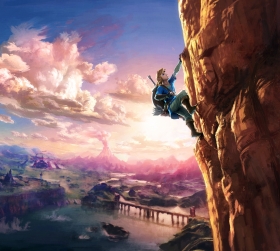
Game Over: The Legend of Zelda: Breath of the Wild
In all my years of playing Nintendo games, The Legend of Zelda series has been a bit of a mystery to me, and it wasn’t until the franchise broke free from its shackles and embarked on a new adventure that I was finally able to sink my teeth into it. So while longtime fans may lament this breaking conventions mindset, I actually find it refreshing, and I feel like the developers at Nintendo were reaching out to people like me who found the older titles uninviting. This attempt at an open world and more freeing Zelda game is, of course, seen in The Legend of Zelda: Breath of The Wild. This was my first Zelda game, and I’ve put way too much time into it, but that’s due to its sprawling landscapes, genius physics system, gorgeous visuals, and player freedom. I’ve played it multiple times now, and after the latest gameplay showcase for Breath of the Wild’s sequel — Tears of the Kingdom — I decided to jump back into the world of Hyrule and fall in love all over again with the experience. It’s not my first rodeo, more like my fourth or fifth.

As I mentioned earlier, Breath of the Wild was my first in the series, I’ve always been more of a Mario fan. I grew up with my Nintendo DS Lite playing New Super Mario Bros. on car rides and during movie nights with my friends and family. Throughout the years, I kept avoiding Zelda because I had no interest in the more linear-focused game designs of titles like Twilight Princess and Skyward Sword. Fast forward to my first year of college and meeting a group of friends who all had a Nintendo Switch, I decided to bite the bullet and buy my first Switch with Super Mario Odyssey. A few weeks later, I would order Breath of the Wild from Amazon and play it, love it, and get killed by a Lynel for the first time. I kept playing, and eventually, I would sprint up to Calamity Ganon and land the final blow on that awful beast. It’s safe to say that I love the game so much that I would return to it time and time again at varying levels of completion. You just discover something new every time you pick it up, and it’s great.
For this playthrough, it had been a few months since I last played, and I had forgotten many of its tricks and discoveries, but after a while, I came to expect most of it. Before booting it up, I decided to do most, if not all, of the side content before embarking on the main story. I also used a guide to get around faster, as I’ve played this title so much that it’s just nice not to be wandering around aimlessly all the time. That’s the great thing about Breath of Wild, though, it’s easy to get distracted, and no single playthrough is ever the same, which I can definitely say for this one in particular. For example, early on, you will most likely come across a friendly Zora resident who nudges the player towards Zora’s Domain, where they will eventually start their first Divine Beast quest. I said no to that and instead made my way to Rito Village so I could get my hands on that awesome Rivali’s Gale ability. Getting that first made traversal so much easier, so next, I ran around while using my trusty guide to scope out and find all the shrines I needed to get enough hearts for the Master Sword. This also made my life so much easier, and it was at this time I decided to do a bunch of sidequests — my favourites being Tarrey Town and Sheep Rustlers.
These two examples have the player doing vastly different things for a singular goal — which could be said for Breath of the Wild as a whole — you’re never doing the same thing for too long. After doing enough shrines and quests, I freed the other Divine Beasts, made my way to Hyrule Castle, and laid Ganon to rest again.

I’ll never say that a subsequent playthrough could ever live up to the first time you see Link standing majestically on that now-famous cliff, but there is something magical about Breath of the Wild, and it’s something I can’t quite put into words. Is it the music? Maybe. Is it the Ghibli-inspired visuals? Possibly. Or is it the developer’s impressive approach to minimising context sensitivity in their work? No idea. Whatever it is, I can honestly say this won’t be my last time in Hyrule, and I eagerly await the sequel.









COMMENTS